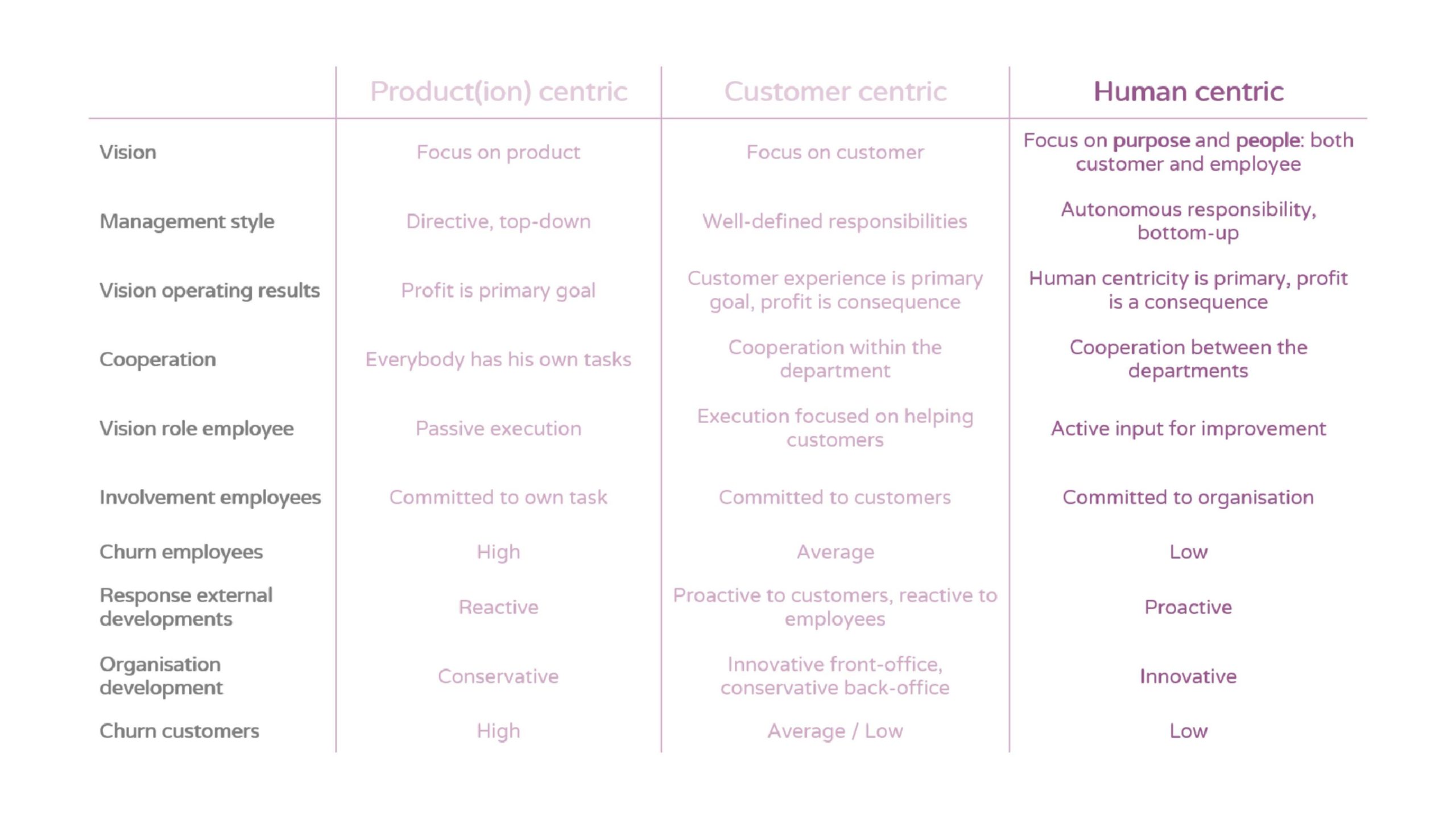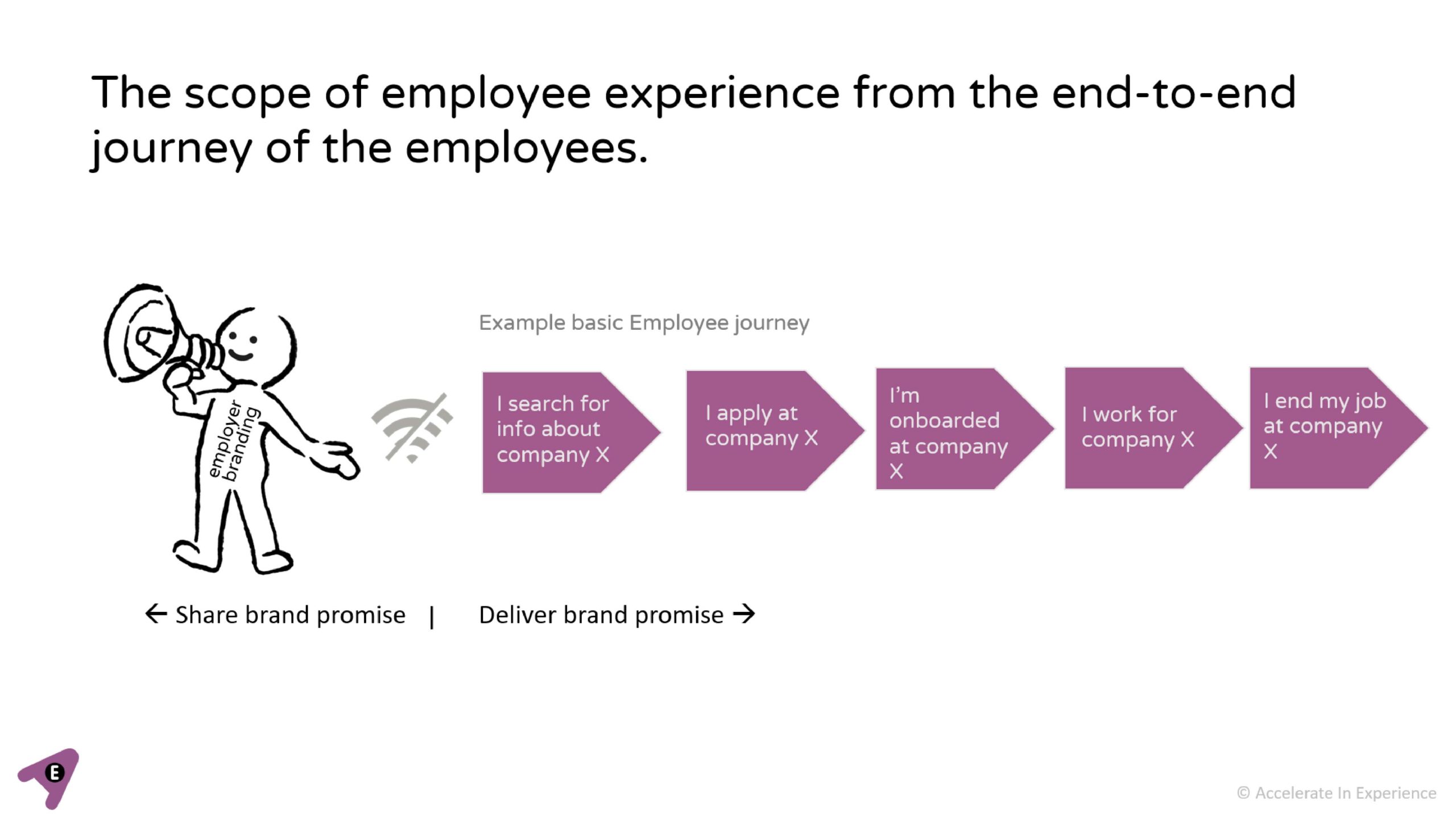Of the 5 types, employee experience is still the most overlooked, though I’m glad to say that it’s been gaining attention recently.
Before delving into the scope of employee experience, I’d like to share with you a bit more of the underlying context.
And that is, that I would like to see organizations becoming more human centric.
After all, none of the experience programs should be an objective in itself.
Their purpose is to render the organization as a whole more customer and human centric (as that’s been the proven route to sustainable and financial success for many years).
I can hear you thinking, that sounds pretty vague, but bear with me and I’ll make it tangible, as always.
Take a look at this table in which I compare a product, customer and human-centric organization.


I won’t explain it in detail, you can read it for yourself, but I will give you a brief account of the transition it entails.
100 years ago, organizations were product centric and Frederik Taylor’s scientific management was born.
Some 30 years ago, they became aware: the product alone no longer suffices, we need to know what our customers want.
Nowadays, more and more organizations are becoming aware: yes, of course the customer is relevant, but the employee is equally crucial!
So why is this transition relevant?
Because the KPI steering developed by Taylor 100 years ago, is still applied in 90% of organizations. And in turn, that affects the employee experience, as you might have guessed (see also this blog on employee engagement based on Dan Cable’s book Alive at work).
Many organizations and also employees have increasingly struggled to relate the sense of purpose of the organization and the reason why they chose the organization to start with.
This is therefore the basis for my approach, to which the 5 types also contribute.
Okay, let’s get back to employee experience.


Scope of employee experience
Very much like customer experience, employee experience concerns my journey with the organization as soon as I have decided to contact the organization to apply for a job there.
How I make that decision, is about the brand experience or employer branding.
I give an example of the steps of the employee journey below.


So the scope of employee experience starts when I’m approached by a recruiter or I check the website of vacancies, right through to actually entering employment and finally leaving again.
Challenges of employee experience
I could name a few once again, but I’d like to concentrate on two challenges for now.
Those two challenges are (1) examining employee experience wearing the same spectacles as customer experience and once again (2) finding the right drivers.
Many tooling companies that measure employee engagement, track 40 to 50 statements or themes each year.
However they often fail to answer the questions of:
- Which of the questions impact engagement?
- Have these questions covered all matters relevant to employees?
- Which of the questions have no impact at all on engagement?
Once again, you need smart statistics to find the drivers, as you did in the case of the customers.
But…. do you remember the crucial factor in finding the right drivers?
Exactly, you need to determine the right metric.
I’d like to share some scientific insights with you, that will allow you to apply your own common sense on how this can best be measured in your own organization.
Metrics of employee experience
I encounter the strangest definitions of employee engagement at companies nowadays.
Taking the mean of the eNPS (would you recommend company X as an employer) and employee satisfaction in order to define employee engagement is possibly the strangest variant, at least from the scientific perspective.
Why?
Because my commitment, which is what employee engagement stands for, is a much more complex phenomenon than that measured by my satisfaction or the eNPS. In fact, these are completely different phenomena.
If you’re looking to activate your employees and release large amounts of energy in your organization, then the emotional commitment is much more important, in both their work and in the organization.
They have the greatest impact on the final target: to retain and particularly engage your employees to make the difference for your customers on a day-to-day basis.
The good news?
There have been useful validated measuring scales around for some time to help organizations determine the drivers, that I actually used and measured in my thesis and still use today in practice.
Take a look at the statements used to measure employee involvement in the organization for example, the so-called “affective commitment”:
- I’m proud to be part of organization X.
- I feel at home at organization x.
- I care about the long-term success of organization X.
As you can see, it is much more emotional than the straightforward question of: would you recommend your employer to others?
Commitment to my job (check the complete measuring scale here) also includes statements such as:
- I’m full of energy at work.
- I feel fit and strong at work.
- I’m enthusiastic about my job.
- My work inspires me.
Do you truly want to measurably improve your employee experience?
Make sure your own employee satisfaction or employee engagement study measures the right matters to find drivers that make the difference in their journeys.
These are therefore the drivers of their emotional commitment rather than satisfaction or eNPS.
Connection to the other types
As I mentioned earlier, one of the challenges of employee experience is to analyze and improve it in the same way as you would for customers.
When it comes to brand experience, you look at ways of not only translating brand values for use in communication so that everyone becomes aware of them, but also what they truly mean to your employees in their daily work.
If your brand promise is simplicity, how simply can I, as an employee, get things arranged within the organization?
Or in terms of service experience: how positive is the employee experience when they need to call the internal customer service or IT help desk? How easy is it to arrange my HR affairs?
The same applies to user experience: how simple is the use of the CRM and all other systems for employees?
There is often more attention for the customer side than for the employee side.
Even though any improvement for employees in this sense, will lead directly to extra valuable time for them to spend on the customer.
But the best connection of all, in my opinion, is that between the customer and employee experience.
And then specifically in the relationship between finding the customer drivers and increasing the purpose for employees (which is often a driver of emotional commitment).
Nine out of ten times, the most important customer drivers are namely exactly the same things that prompted employees to choose the organization to start with.
And not those matters that have been given much more focus by the organization, for all kinds of reasons (achieving KPIs, handling x number of calls, processing x number of files, x more sales, etc.).
Employees have unintentionally moved further and further away from the purpose of the organization and therefore the purpose of their own work.
And in identifying those drivers, you’re actually speaking the hard language of the organization in terms of steering information, while speaking the soft language of purpose and making the difference for customers and employees.
A super win-win that will get the entire organization on board.
To summarize
To improve employee experience, make use of all the techniques already deployed for other types of experience, for customers.
And make sure to certainly check how your own employee engagement survey works, to be certain that you are twiddling the right knobs.
If you can also connect that to a long-term vision, added purpose and a transition to a more human-centric culture, you’ll have the perfect background for realization of the required transformation.
Another tip: use the table given in the intro to carry out the following exercise in your management team:
- Where do we now stand?
- Where do we want to stand?
- Are we doing the right things to move in that direction?
Once again, there is no holy truth, but rather an extremely valuable mutual discussion to learn about each others’ views of an abstract subject such as customer centricity, for example.
In this brief video, I summarize the employee experience type in 1 minute.
In the following blog, we’ll be looking at service experience!
Want to know more about Employee Experience? Two online training tips!
In the complete Accelerate In Experience training you can find the Employee Experience module, in which you’ll learn all about how you can be successful with EX in your own organisation and how to connect EX to the 4 other types of experience. For now looking for purely EX as a start? Then the module Employee Experience can also be done separately.


